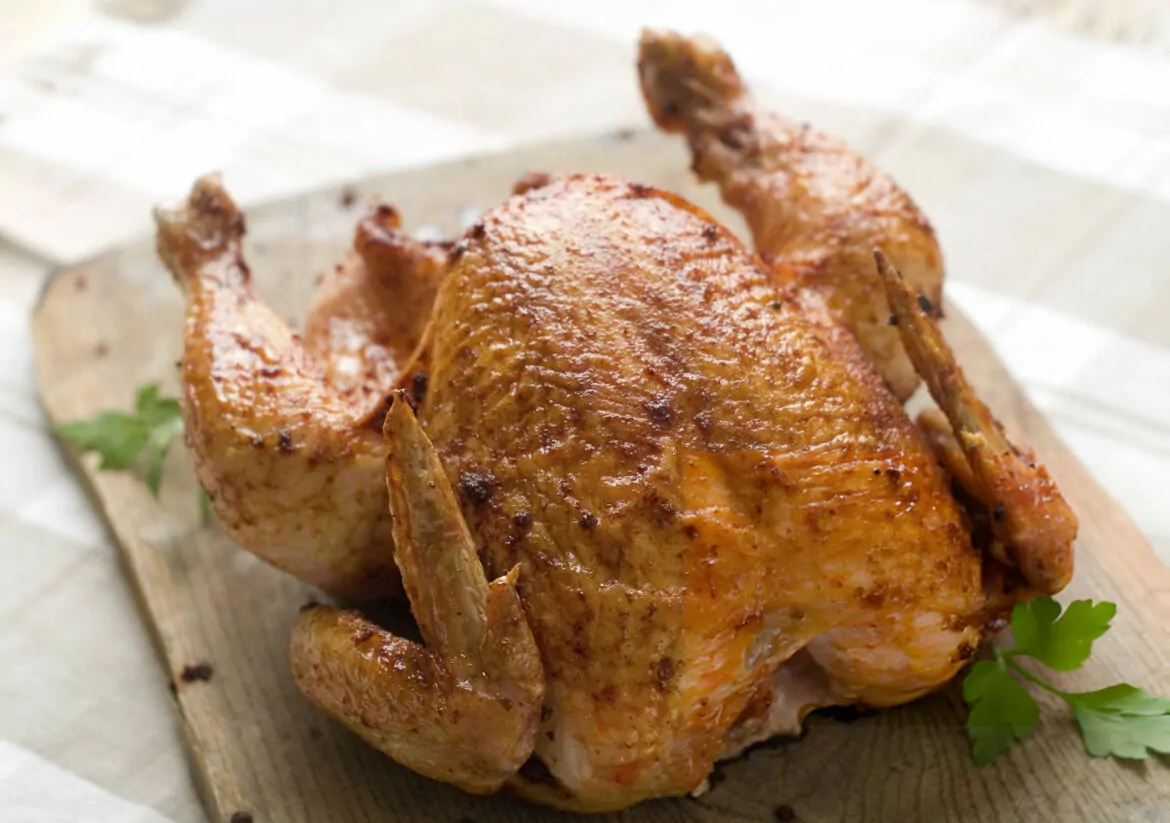Roast chicken is a timeless dish that graces tables with its succulent flavor and golden, crispy skin. Whether it’s for a casual family dinner or a special occasion, this versatile recipe is sure to impress. The beauty of roast chicken lies in its simplicity and the endless possibilities for customization. From the herb-infused butter to the savory aroma filling your kitchen, this dish captures the essence of comfort food while offering a canvas for culinary creativity.
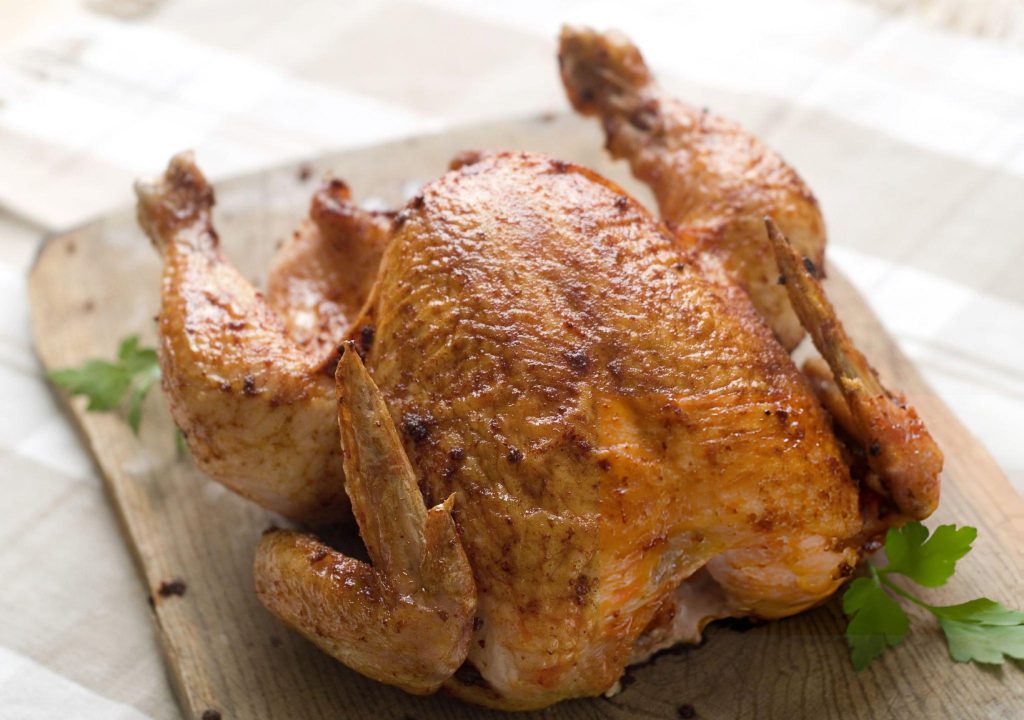
The key to a successful roast chicken is selecting the best ingredients and following a few essential steps to ensure perfection. Let’s dive into the details of this recipe, exploring the ingredients that make it special and the techniques that guarantee a mouthwatering result every time.
Ingredients Overview
The foundation of a perfect roast chicken starts with the right ingredients. A fresh, high-quality whole chicken is the star of this recipe. Opt for a chicken weighing between 1.75 to 2 kilograms (3.5 to 4 pounds) to ensure even cooking and juicy meat. Pat the chicken thoroughly dry before seasoning to help achieve that coveted crispy skin.
Lemon and rosemary are classic flavor companions that infuse the chicken with a bright, earthy aroma. The quartered lemon, placed inside the cavity and squeezed over the skin, adds a zesty tang that balances the richness of the meat. Rosemary sprigs, tucked into the cavity, release their fragrant oils as the chicken roasts, permeating the meat with their piney essence.
The butter mixture is where the magic happens. Melted unsalted butter, combined with minced garlic, sage, rosemary, parsley, salt, and black pepper, creates a luscious, herb-infused coating that keeps the chicken moist and flavorful. The butter is carefully spread under the skin to ensure the meat remains tender while the skin crisps up beautifully.
Finally, the roasting process is enhanced by a base of dry white wine or low-sodium chicken broth, along with quartered onion and halved garlic bulb. These ingredients not only add depth to the pan juices but also keep the chicken elevated during roasting, allowing the heat to circulate evenly for a perfectly cooked bird.
Step-by-Step Instructions for a Juicy and Flavorful Roast Chicken
Achieving the perfect roast chicken involves a series of carefully executed steps. Start by allowing the chicken to come to room temperature for 30 minutes before cooking. This ensures even cooking throughout. Preheat your oven to 220°C (450°F) for standard ovens or 200°C (430°F) for fan/convection ovens, placing a rack in the middle to position the chicken at the optimal height.
Begin by preparing the butter mixture. Melt the butter and mix it with the minced garlic, finely chopped herbs, salt, and pepper. For an added burst of flavor, squeeze the juice from two lemon wedges into the mixture. This butter will act as both a marinade and a basting liquid, ensuring the chicken stays moist while developing a rich, golden crust.
Place the chicken breast-side up in a roasting pan. Using a dessert spoon, gently separate the skin from the meat over the breast and drumsticks, being careful not to tear the skin. This step is crucial for getting the butter mixture directly onto the meat, which helps to keep it juicy. Spoon the majority of the butter mixture under the skin, saving a small portion to coat the exterior of the chicken.
Rub the remaining butter mixture all over the chicken’s exterior, ensuring it is well-coated. Squeeze the juice from the remaining lemon wedges over the chicken for an extra layer of flavor. Stuff the used lemon wedges and rosemary sprigs into the cavity to infuse the meat from the inside out.
Secure the drumsticks together with kitchen string and tuck the wing tips beneath the bird to prevent them from burning. Season the chicken generously with salt and pepper. Arrange the quartered onion and halved garlic bulb around the chicken in the roasting pan, then pour the wine or chicken broth around the bird. A light drizzle of olive oil over the chicken will help the skin to brown and crisp in the oven.
Transfer the roasting pan to the preheated oven and cook the chicken at the high temperature for 10 minutes to kickstart the browning process. Then, reduce the oven temperature to 180°C (350°F) and continue roasting for approximately 1 hour and 15 minutes. The chicken is done when it reaches an internal temperature of 75°C (165°F) or when the juices run clear when pierced at the thickest part of the drumstick. Baste the chicken twice during the roasting process, first at 30 minutes and again at 1 hour, using the flavorful pan juices.
Once the chicken is cooked to perfection, remove it from the oven and let it rest for 15 minutes before carving. Resting is essential to allow the juices to redistribute throughout the meat, ensuring each bite is moist and flavorful. Resist the urge to cover the chicken during this time, as it will cause the skin to lose its crispiness. Serve the chicken with the pan juices, discarding the onion but keeping the roasted garlic for added flavor.
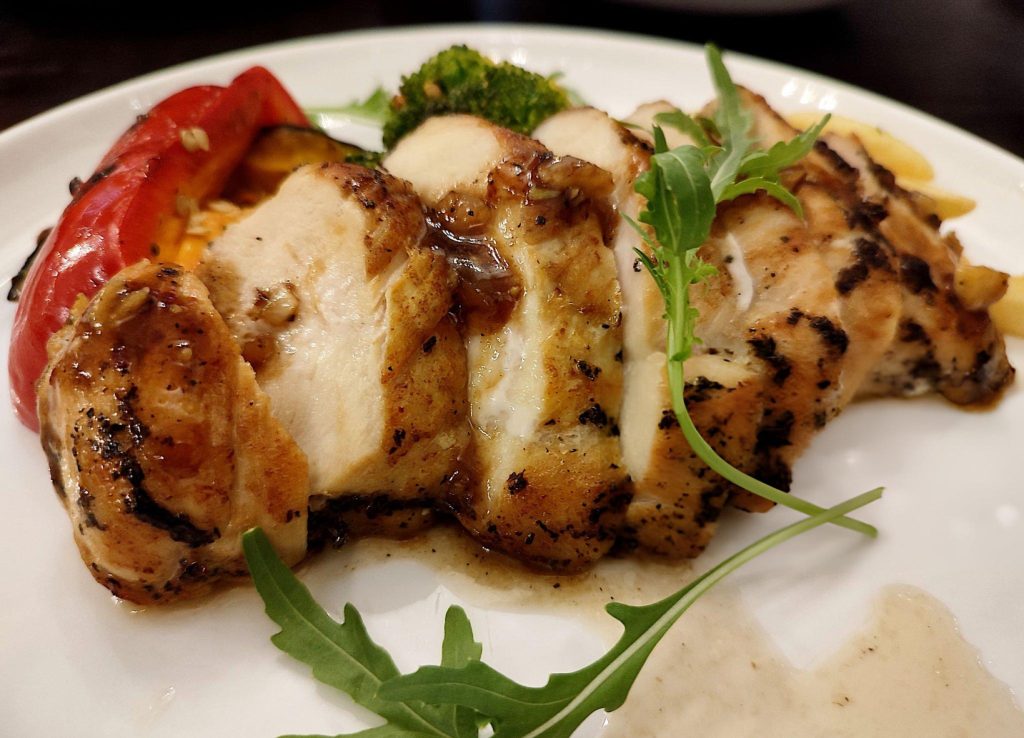
Recipe Tips for Success & Frequently Asked Questions
- Tips for Ensuring Crispy Skin and Juicy Meat:
- Thoroughly pat the chicken dry before seasoning.
- Spread the butter mixture under the skin to keep the meat moist.
- Do not cover the chicken while it rests to maintain crispy skin.
- Suggestions for Adjusting Flavors:
- Experiment with different herbs like thyme or oregano.
- Add a touch of honey to the butter mixture for a hint of sweetness.
- Advice on How to Avoid Common Mistakes:
- Avoid overcooking by checking the internal temperature.
- Ensure the oven is preheated to the correct temperature before roasting.
- Answers to Common Questions:
- Cooking time varies with the size of the chicken; use a meat thermometer for accuracy.
- If the chicken is dry, baste more frequently or try brining before roasting.
- Solutions for Common Problems:
- Uneven cooking can be mitigated by bringing the chicken to room temperature before roasting.
- Dry meat can be salvaged by serving with plenty of pan juices or gravy.
- Tips on Substituting Ingredients:
- Use vegetable broth instead of wine or chicken broth for a different flavor profile.
- Substitute thyme or tarragon for rosemary for a new twist.
What to Serve with This Roast Chicken
Roast chicken is a versatile main dish that pairs beautifully with a variety of sides. For a classic pairing, serve it with buttery mashed potatoes and roasted vegetables like carrots, parsnips, and Brussels sprouts. The earthy flavors of these sides complement the herbaceous notes of the chicken, creating a harmonious meal.
If you prefer a lighter accompaniment, a crisp green salad with a tangy vinaigrette or steamed asparagus with lemon zest will balance the richness of the roast chicken. For a more decadent option, consider serving the chicken with creamy polenta or a cheesy gratin.
When it comes to beverages, a crisp white wine like Sauvignon Blanc or Chardonnay pairs well with the lemony, herbal notes of the chicken. For those who prefer red wine, a light-bodied Pinot Noir is a delightful choice. If you’re serving the chicken with a rich gravy or sauce, a fuller-bodied red like Merlot or Syrah can stand up to the robust flavors.
To elevate the meal further, consider making a homemade gravy from the pan juices. Simply deglaze the roasting pan with a bit of additional wine or broth, then simmer with flour or cornstarch to thicken. The resulting gravy will be rich, savory, and the perfect complement to the tender chicken.
How to Use Leftovers Creatively
Leftover roast chicken is a gift that keeps on giving, offering endless possibilities for creating new meals. One of the simplest ways to use leftover chicken is to shred it and add it to salads, sandwiches, or wraps. The juicy, flavorful meat will elevate these dishes, making them more satisfying and delicious.
For a quick and comforting meal, use the leftover chicken to make a hearty chicken soup or stew. Simply sauté some onions, carrots, and celery, add chicken broth, and toss in the shredded chicken along with your favorite vegetables and pasta or rice. The result is a nourishing bowl of comfort that’s perfect for any time of year.
Another great use for leftover roast chicken is to make a chicken pot pie. Combine the shredded chicken with a creamy sauce, peas, carrots, and onions, then top with a flaky pastry crust. Bake until golden and bubbly for a comforting dish that’s sure to please.
If you’re in the mood for something different, try making chicken tacos or quesadillas. Simply warm the shredded chicken in a skillet with some taco seasoning, then serve in warm tortillas with your favorite toppings like avocado, salsa, and cheese. It’s a fun and flavorful way to repurpose your leftovers.
Don’t forget about the chicken carcass! It’s perfect for making a rich, homemade broth. Simply simmer the carcass with onions, carrots, celery, and herbs for a few hours, then strain and use the broth as a base for soups, stews, or risottos. The broth will be packed with flavor and nutrients, making it a valuable addition to your kitchen repertoire.
Enjoying Your Perfect Roast Chicken
A well-roasted chicken is a culinary triumph, combining simplicity with depth of flavor. By following this recipe and paying attention to the details, you can create a roast chicken that’s juicy, flavorful, and sure to become a family favorite. Whether you’re serving it for a special occasion or a weeknight dinner, this dish is a testament to the beauty of home-cooked meals.
Remember to enjoy the process and don’t be afraid to experiment with different herbs, spices, and side dishes. The versatility of roast chicken allows you to tailor it to your preferences and the ingredients you have on hand. With a few simple techniques and quality ingredients,
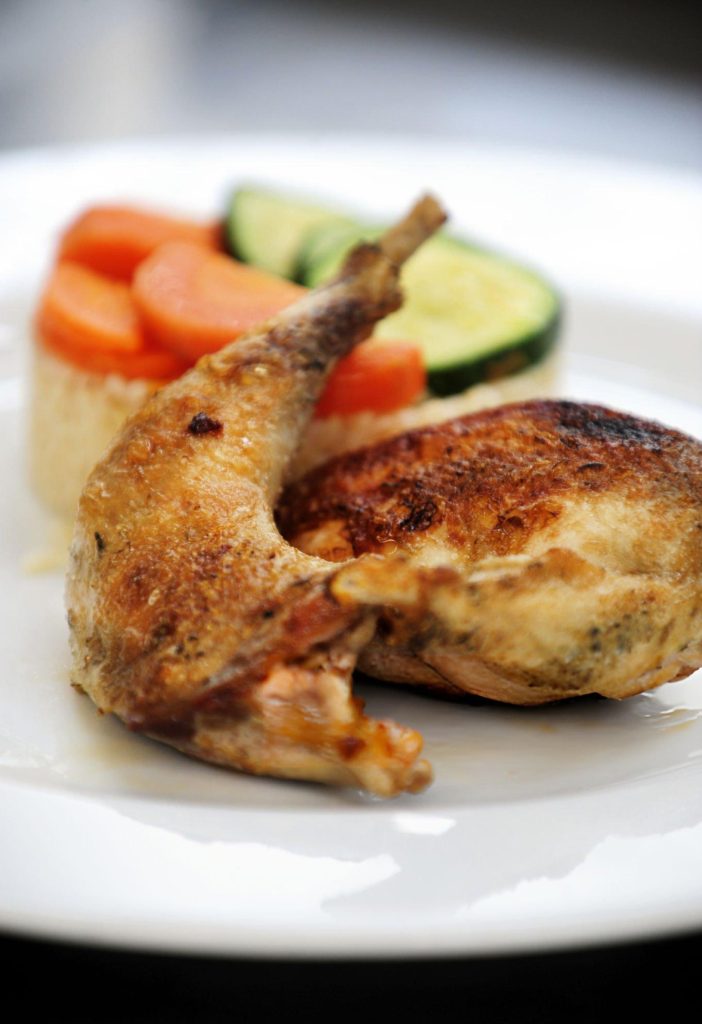
Ingredients
- 1 lemon, quartered
- 3 rosemary sprigs
- Salt and pepper
- 2 tsp olive oil
- 1.75 – 2 kg / 3.5 – 4lb whole chicken, thoroughly patted dry
Butter Mixture:
- 100 g / 1 stick unsalted butter, melted
- 3 garlic cloves, minced
- 1 tbsp sage, finely chopped
- 2 tsp rosemary, finely chopped
- 1 tbsp parsley, finely chopped
- 1/2 tsp each salt and black pepper
For Roasting:
- 1 onion, quartered
- 1 garlic bulb, halved horizontally
- 1 cup / 250 ml dry white wine, or low-sodium chicken broth
Instructions
Remove the chicken from the refrigerator 30 minutes before you begin cooking to allow it to reach room temperature. Preheat your oven to 220C/450F (standard) or 200C/430F (fan/convection), positioning a rack in the center.
In a bowl, combine the melted butter with the minced garlic, chopped herbs, salt, and black pepper. Squeeze the juice from two lemon wedges into the mixture, stirring to combine.
Place the chicken breast-side up in a roasting pan. Gently separate the skin from the meat over the breast and drumsticks using a dessert spoon. Carefully spoon the butter mixture under the skin, making sure to spread it evenly. Save a small portion of the butter mixture to coat the outside of the chicken.
Rub the remaining butter mixture all over the chicken’s exterior, ensuring the entire surface is well-coated. Squeeze the juice from the remaining lemon wedges over the chicken.
Stuff the cavity of the chicken with the used lemon wedges and rosemary sprigs. Secure the drumsticks together with kitchen string, and tuck the wing tips beneath the bird to prevent burning. Season the chicken generously with salt and pepper.
Scatter the onion quarters and halved garlic bulb in the roasting pan, then place the chicken on top. Pour the white wine or chicken broth around the chicken and drizzle the skin with olive oil.
Transfer the roasting pan to the oven and cook for 10 minutes at the preheated temperature. Then, reduce the heat to 180C/350F (all oven types) and continue roasting for 1 hour and 15 minutes, or until the internal temperature of the chicken reaches 75C/165F. Alternatively, check if the juices run clear when the thickest part of the drumstick is pierced. Baste the chicken twice during cooking—once at 30 minutes and again at 1 hour—using the pan juices.
Once the chicken is done, let it rest for 15 minutes before carving. Do not cover it during this time, as this will keep the skin crisp. Serve the chicken with the pan juices, discarding the onion but keeping the roasted garlic for added flavor.
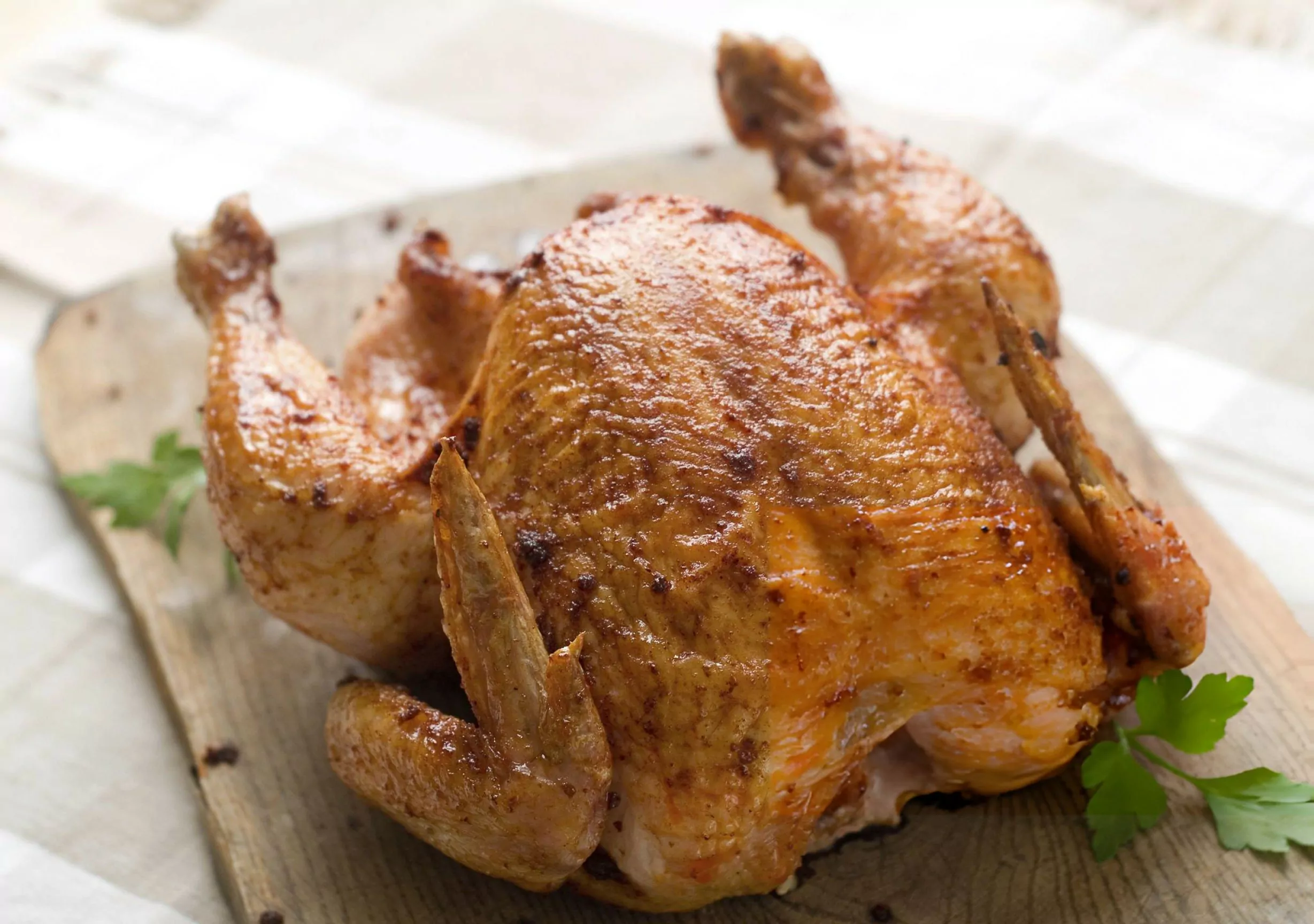
Roast Chicken Recipe
Ingredients
- 1 lemon quartered
- 3 rosemary sprigs
- Salt and pepper
- 2 tsp olive oil
- 1.75 – 2 kg / 3.5 – 4lb whole chicken thoroughly patted dry
Butter Mixture:
- 100 g / 1 stick unsalted butter melted
- 3 garlic cloves minced
- 1 tbsp sage finely chopped
- 2 tsp rosemary finely chopped
- 1 tbsp parsley finely chopped
- 1/2 tsp each salt and black pepper
For Roasting:
- 1 onion quartered
- 1 garlic bulb halved horizontally
- 1 cup / 250 ml dry white wine or low-sodium chicken broth
Instructions
- Remove the chicken from the refrigerator 30 minutes before you begin cooking to allow it to reach room temperature. Preheat your oven to 220C/450F (standard) or 200C/430F (fan/convection), positioning a rack in the center.
- In a bowl, combine the melted butter with the minced garlic, chopped herbs, salt, and black pepper. Squeeze the juice from two lemon wedges into the mixture, stirring to combine.
- Place the chicken breast-side up in a roasting pan. Gently separate the skin from the meat over the breast and drumsticks using a dessert spoon. Carefully spoon the butter mixture under the skin, making sure to spread it evenly. Save a small portion of the butter mixture to coat the outside of the chicken.
- Rub the remaining butter mixture all over the chicken’s exterior, ensuring the entire surface is well-coated. Squeeze the juice from the remaining lemon wedges over the chicken.
- Stuff the cavity of the chicken with the used lemon wedges and rosemary sprigs. Secure the drumsticks together with kitchen string, and tuck the wing tips beneath the bird to prevent burning. Season the chicken generously with salt and pepper.
- Scatter the onion quarters and halved garlic bulb in the roasting pan, then place the chicken on top. Pour the white wine or chicken broth around the chicken and drizzle the skin with olive oil.
- Transfer the roasting pan to the oven and cook for 10 minutes at the preheated temperature. Then, reduce the heat to 180C/350F (all oven types) and continue roasting for 1 hour and 15 minutes, or until the internal temperature of the chicken reaches 75C/165F. Alternatively, check if the juices run clear when the thickest part of the drumstick is pierced. Baste the chicken twice during cooking—once at 30 minutes and again at 1 hour—using the pan juices.
- Once the chicken is done, let it rest for 15 minutes before carving. Do not cover it during this time, as this will keep the skin crisp. Serve the chicken with the pan juices, discarding the onion but keeping the roasted garlic for added flavor.
Notes
- Herbs: Rosemary and sage are time-honored companions to chicken, while parsley brings a pop of color and a hint of freshness to the butter. You can experiment with your favorite herbs, but use rosemary sparingly as its strong flavor can easily overpower. If using dried herbs, substitute with 2-3 teaspoons—opt for 2 teaspoons of potent herbs like thyme, oregano, or tarragon, or 3 teaspoons of milder herbs like dill or parsley.
- Onion and Garlic: These ingredients serve a dual purpose: they lift the chicken slightly out of the liquid and infuse the pan juices with rich flavor, perfect for making a sauce. I typically don’t peel the onion since it often becomes too greasy to eat after roasting under the chicken. However, you can peel the onion and enjoy it if you prefer.
- Garlic-Herb Butter: The majority of the garlic-herb mixture should be spread under the chicken skin. If too much is left on the surface, the garlic may burn during roasting. Focus on getting that flavor-packed mixture beneath the skin where it can seep into the meat.
-
Gravy Option:
- 50 g / 3 tbsp butter
- 3 tbsp / 40 g flour (any white)
- 2 cups / 500 ml liquid from pan, topped up with low-sodium chicken broth
- Cook Times: Start by roasting the chicken at 220C/450F for 10 minutes, then reduce the heat to 180C/350F and cook for 20 minutes per 500g/1lb, until the internal temperature reaches 75C/165F or the juices run clear. If the chicken is straight from the fridge, add an additional 10 minutes to the cooking time.
- Tying Drumsticks: The simplest way to tie drumsticks is to loop a single piece of string around one leg, pull the other leg closer, and loop the string around it as well. Once both legs are wrapped, use the string to pull them together tightly, crossing them over each other to secure.
- Carcass and Leftover Bits/Juices: Toss the carcass and any leftover bits into a pot or slow cooker, cover with water so it’s about 2.5 cm / 1 inch above the chicken, and add 2 teaspoons of Vegeta or chicken stock powder (or 2 crumbled cubes), along with chunky pieces of celery, carrot, garlic cloves, and fresh herbs like thyme, rosemary, or parsley (or 1 teaspoon of dried herbs). Simmer for 1 hour or cook in the slow cooker for 6 hours, then strain. Save any remaining chicken for soup and use the broth for Chicken Noodle Soup or Chicken Rice Soup.
- Sides: For sides, try roasted potatoes (toss cut pieces in olive oil, salt, pepper, and herbs, then roast under the chicken for 40 minutes), mashed potatoes, cauliflower, or garlic bread. Potatoes au Gratin or Easy Cheesy Potato Bake are also excellent choices and can be made ahead and reheated. If you’re in the mood for a salad, consider a Kale Quinoa Salad (great for meal prep as it lasts for days), or other fresh options like Corn Salad with Avocado and Tomato, Roast Pumpkin Spinach Salad, or a simple garden salad with Italian or French dressing.

